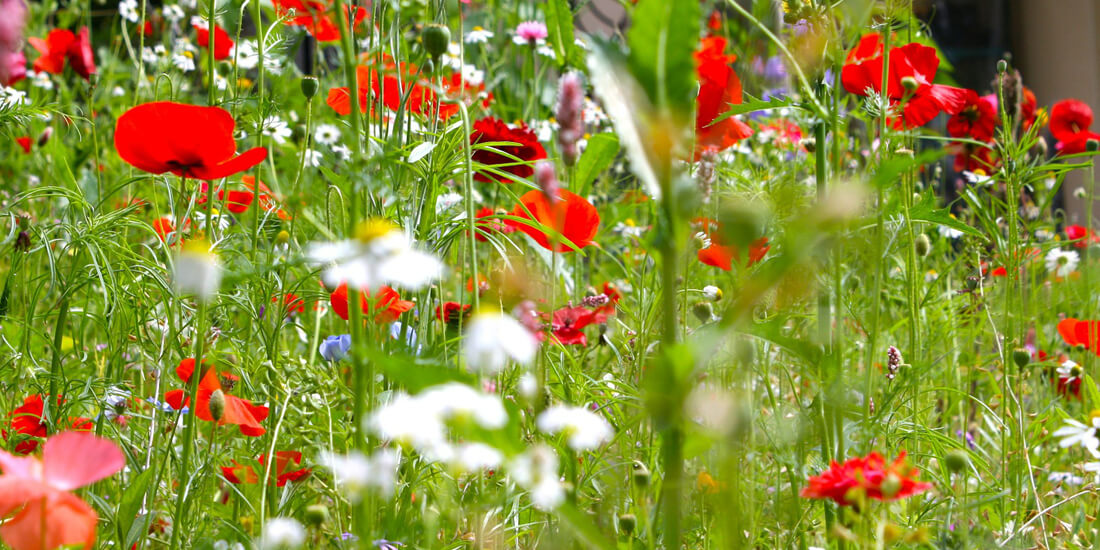How to sow wildflower seeds in your garden

Wildflowers add a variety of vibrant and versatile blooms to your garden, adding a vast range of colour shapes and providing food for pollinators and local wildlife! Below, we outline how to sow your wildflower seeds to ensure your wildflower meadow blooms as beautifully!
We also explore the best times of the year for when to sow wildflower seeds and take a look at how to pick the best wildflower seeds and wildflower seed mixes.
Jump to:
- How to sow wildflower seeds
- When is the best time to sow wildflower seeds in the UK
- How to pick the best wildflower seed mixes
How to sow wildflower seeds
Start by clearing out any pesky grass, weeds, and competing flora from the designated area to give your seeds the best chance to thrive. Here’s what comes next:
- Trim the top 5-10cm of soil to reduce its fertility (since wildflowers prefer poorer soil conditions).
- Let the area sit for a few weeks, diligently plucking out any stubborn weeds that dare to sprout during this period.
- Resist the urge to supplement with topsoil, compost, or fertilisers—wildflowers prefer their soil on the lean side.
- After you have readied the soil for planting, we recommend allowing the soil to settle for up to 6 weeks.
- Once the soil has had time to settle, tidy up by removing any rocks or debris and give it a good raking to achieve a smooth, crumbly surface.
- Sprinkle the seeds at a rate of 5g per square meter.
- Gently rake the seeds into the soil, ensuring they’re snug and secure.
- Give your newly sown seeds a thorough watering.
With these steps, you’re well on your way to a vibrant wildflower display!
Here are a few extra tips for sowing wildflower seeds
- If you’re sowing during a dry spell, keep a watchful eye and water as needed to maintain moisture levels during the crucial first six weeks.
- For the most promising growth, it is vital that the soil is warm and does not dry out.
- Ensure you water your soil regularly, especially if there is a hot or dry weather spell.
When to sow wildflower seeds?
“When to sow wildflower seeds” is one of the most common queries when it comes to planting and growing these beautiful plants. For this, we suggest opting for wildflower planting during the ideal sowing season, typically spanning from March to October. Expect the delightful burst of wildflowers to grace your garden approximately 60-80 days post-sowing.
When will my wildflower seeds bloom if I sow them in spring?
If you sow in early spring, around March or April, you will be rewarded with a vibrant display of annuals during the summer months.
When will my wildflowers bloom if I sow them in autumn?
Sowing your wildflower seeds in early autumn - around September or October - will ensure their appearance come the following spring. Aim to sow in early autumn if you wish to enjoy your blossoming wildflowers in early springtime.
Selecting the best wildflower seeds for your garden
Although wildflowers can grow virtually anywhere, some seed types grow better in a wide range of conditions than others. The wildflower mix you choose will affect your wildflower meadow’s performance when planting wildflower seeds in the UK (and in similar temperate climates). Please note that wildflower seed mixes that do not contain grass will provide an ornamental display but will not offer a year-round habitat for wildlife.
Wildflower species for normal soil types in non-shaded areas
- Annuals Mix (does not include grass) – contains the nation’s favourite cornfield annuals for an ornamental display.
- Meadow Magic (does not include grass) - contains a mix of UK native annuals and perennials for an ornamental display.
- Flowering Meadow (includes grass) – contains a mixture of UK native annuals and perennials approved by RHS Plants for Pollinators and complement arable grasses.
- Bees and Pollinators (includes grass) - contains a mixture of UK native annuals and perennials that are excellent at attracting bees and pollinators and are approved by RHS Plants for Pollinators. This mix also contains complimenting arable grasses.
Wildflower seed mixes suited to shaded areas
- Shaded Area Wildflowers (includes grass) - contains UK native annual and perennial wildflowers that are shade tolerant and can be typically found growing naturally in forested areas.
Wildflower seeds for problematic soils
- Heavy Clay Soil Wildflower (includes grass) – contains UK native annual and perennial wildflowers that thrive in clay soils and also contains complementing arable grasses.
- Sandy Soil Wildflower (includes grass) – contains UK native annual and perennial wildflowers that thrive in sandy soils and also contains complementing arable grasses.
Please read our wildflower meadow management guide for details on how to keep your wildflower meadow flourishing. We also have helpful advice on our range of UK wildflower seeds and tips for growing grass seed throughout the year.